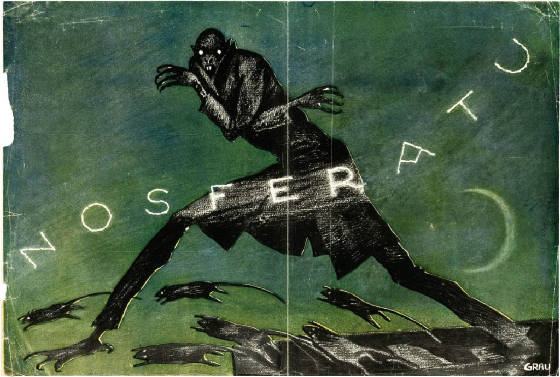|
|
 |
|

(1922, directed by F.W. Murnau)
- inducted 2018 –
“Among the most celebrated effects of The German Expressionist Movement was that of bringing to external life an interior
subjective headspace. The nightmare, the hallucination, the vision of the madman. Nosferatu achieves something altogether
more difficult and more insidious, that of the interior nightmare spilling over and breaching into the orderly rational world.
Breaching the walls of reality and poisoning what it finds there. In perhaps the film's most effective scare sequence, the
hero Sutter watches as Count Orlock inexorably approaches his room from down a long hallway. He acts as a child would, pulling
the bed covers over his head. And in this gesture we experience not merely a sense of fairy tale dread, but a sense of fairy
tale dread invading reality. Poor Sutter has simply no way to react but to fall sprawling back into the very first instincts
of fear.
“Indeed for a film that is pushing one hundred and is not without its dated aspects, (the leads often express their
consternation by seemingly trying to jam their entire fists into their mouths) it is remarkable just how much of Nosferatu
still works as a horror movie. How much of it retains its ability to cause fear. Much of this is of course due to Max Shrek's
turn as Orlock, still one of the most iconic performances in horror - an embodiment of decay and bad death as yet unrivaled
(even by Klaus Kinski who knew a little something about both). The makeup is iconic, but it's in the body language, in the
stiff unfamiliar poses and lurching movements. It is no mistake that whenever anyone takes it into their head to make vampires
scary again they so often come back to this design, the bald pate, sunken eyes, hands like jagged claws. Vampirism not as
an ascent up the evolutionary chain but a long slide down it, into the feral waiting arms of our worst hungers and impulses.
“Watching a creature who has given in so completely to its lack of humanity is what gives Nosferatu its eerie,
enduring power. It is this creature's symphony to which we listen.”
~ Bryce Wilson
|
 |
|
Original title: Nosferatu, eine Symphonie des Grauens
Principal cast: Max Schreck, Gustav von Wagenheim, Greta Schröder, Alexander Granagh, Georg H. Schnell, Ruth Landshoff, John
Gottowt, Gustav Botz, Max Nenetz, Wolfgang Heinz, Albert Venohr, Eric van Viele
Screenplay by Henrik Green
Produced by Enrick Dickemann, Albin Grau
Director of photography: F.A. Wagner
Art direction by Albin Grau
Costume design by Albin Grau
Original music by Hans Erdmann
Based on the novel Dracula by Bram Stoker (uncredited)
Germany
Duration: 94 minutes
Languages: Silent with German intertitles
Filmed in black and white
Sound mix: Silent
Aspect ratio: 1.33:1
Produced by Jofa-Atelier Berlin-Johannisthal, Prama-Film GmbH
Released in USA by Film Arts Guild
Premiered in The Hague, Netherlands on 17 February 1922
USA release date: 3 June 1929
Awards and honors:
- Selected as one of Roger Ebert’s “Great Movies,” 28 September 1997
|
 |
|
|
 |
|
|
 |
|
|
|
|
|
|
 |

